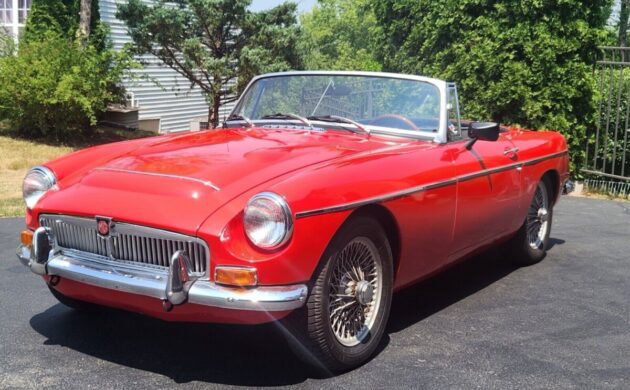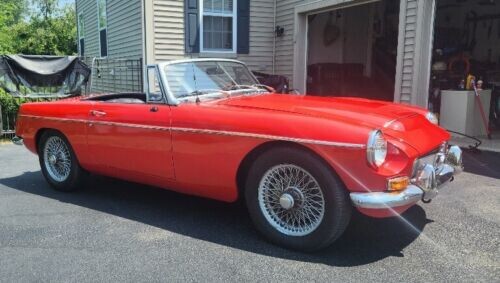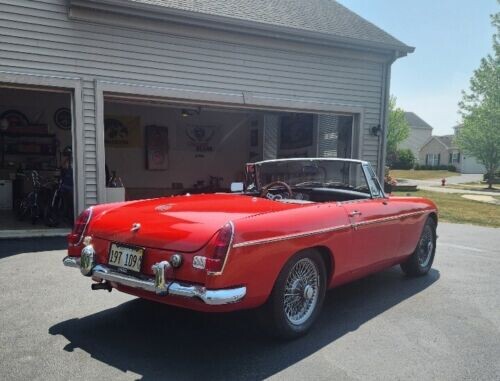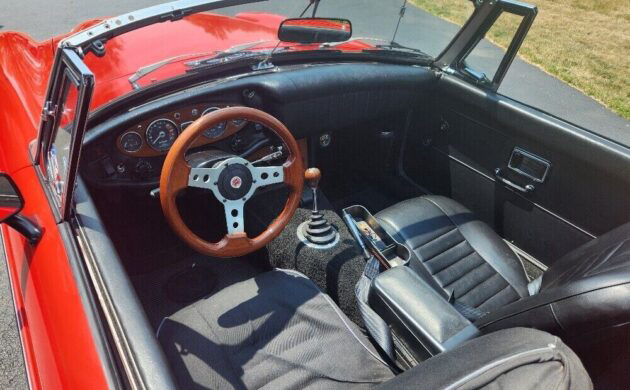The Austin Healey 3000 was a beloved and beautiful roadster with legions of fans on both sides of the Atlantic. One of its most admired features was the smooth inline six-cylinder engine under its hood. When that car’s production ended in 1967, British Motor Corporation replaced it with a version of the popular MGB with a different inline-six. The effort was difficult, and the rewards were few. Today, these rare cars, dubbed MGCs, are an interesting variant of the MGB that is highly prized. If you are looking for a good driver version of this rare bird, then take a look at this 1969 MG MGC for sale on eBay in Wauconda, Illinois. Bidding is currently at $9,200 for this little red sportscar that runs and drives but needs a little bit of TLC to be perfect. Is the inline six still worth a premium over a standard MGB?
Sports car buyers in the late 1960s were living their best days. Many of the choices on the showroom floor would go on to become highly desired as collectibles. The Austin Healey 3000 was among these, and for good reason. The styling that originated with the Austin Healey 100 series was stretched to add a Lilliputian back seat and refined into more of a luxury sports car look. Under the hood was a smooth inline six-cylinder engine that was backed with a four-speed transmission that was available with overdrive. One could say it was a sports car for a more distinguished and affluent enthusiast.
The problem was that the car was rooted in an older design that wouldn’t lend itself well to upcoming emissions and crash standards. Add to that the fact that the British Motor Corporation was not able nor was it interested in providing the funds to design a successor. So, in mind-numbing BMC fashion, management determined that the 3000 would be replaced with a version of the MGB with an inline-six transplanted under the hood. The conversion turned out to be anything but easy and the amount of work needed drove the price up to a point where customers didn’t see the value in it. Sales of both the roadster and hard top versions were abysmal. The experiment lasted from 1967 until the last stragglers were sold in 1970.
Roll the clock forward to 2023, and these cars are still a subject of debate among MGB aficionados. While they do make for a very nice long-distance touring car and the inline-six is still buttery smooth, the question is how much more should one pay for an MGC over a comparable MGB? There is also the issue of MGC-specific parts being much harder to source than standard MGB pieces. While MG fans instantly recognize the MGC-specific bulged hood, others have no idea the car is anything but a run-of-the-mill MGB. As one can see, the debate is the same as it was when the car showed up on dealership floors in 1967.
The MGC you see here is a car that was retained in the seller’s family for decades. Passed from the original owner to the seller’s grandfather, the car was then given to the seller’s father. The seller’s dad was a true British car nut and soon embarked on a restoration of the car. That restoration was mechanically extensive and resulted in the rebuilding of the unique power plant. The odometer reads 65,020 miles, but likely 2,000 of that is all that the rebuilt engine has traveled. Another big plus is that the car is equipped with the highly desirable overdrive unit for the four-speed manual transmission.
As a restoration completed in the 1990s, the car has a few issues here and there that will need to be rectified. Tires will need to be replaced, some interior trim will likely force an order with Moss Motors, and the usual mechanical woes of a car that has sat for a while will always rear their ugly heads. More ominously, rust has begun to become an issue in the floors and the inner rocker panels. These are described as spots. Given that rust is the mortal enemy of every single one of the 500,000+ MGBs built, the new owner should immediately address these concerns aggressively.
Still, this is a running and driving MGC that is very presentable as it sits. If you are looking for an MGC, then this car should be on your list. The rust issue doesn’t look to be a deal killer and these cars do have a certain appeal to those of us who like to do long trips in older cars. It is up to you to determine if that inline-six under the hood is worth a premium in price.
What do you think should be the price difference between otherwise equal MGBs and MGCs? Would you pay extra for a six-cylinder engine? Let us know your thoughts in the comments.











If you have money to buy unique over tradition the C is the car for you. Without suit cases full of traveling clothes and the idea to go on a trip the C didn’t match it’s siblings as a true sports car. You might want to leave the suit cases in the trunk if you wanted to go to the weekend autocross as the cars were the worst handling cars on the road due to the front/back weight difference. They can be made to handle but it takes a fat wallet to accomplish that. That said, the couple people we know who have the hard top versions say that a lot of that goes away due to the additional weight of the top.
There was a “C” GT racing at Road America last Sept. I have a photo but I can’t get it uploaded here.
Owned a MGC GT back in the 70’s. A 6 banger with a two speed electric overdrive made the driving experience completely different than that of the B.
Worth the price and worth the investment to address required repairs.
I love B’s (and by extension, C’s…sort of).
A B is a slug, even by past standards, not to mention today’s. The C is a slug+, even with the bigger engine.
Cute and classy, but slugs. Until the V8 versions came along, or enthusiasts stuffed V8’s into them.
Auction just ended. SOLD for $9,999.
Owned one for many years in that exact shade of red too. Second the cautioning on rust and hard to source parts. A sloppy steering rack will be impossible to replace. Motor is bullet proof when done properly. I rebuilt mine with a .60 overbore, triple carbs, 3/4 cam and more. It was pretty surpising to a few guys in muscle cars of the day.
As many have commented the MGCs are not very peppy because of the added weight but they are great cruising cars.
I’m still driving my 1969 Mineral Blue C bought new in ’69, and continue to get thumbs up all the time
As with so many cars, it all depends on what you want. If you want a zippy little car to take to the autocross, or a racy little thing to slide around gravel corners on country roads, a pepped-up MGB (or a Miata) is perfect.
Much of the MGC’s failure was because disappointed press testers unfairly expected an MGB with all the same handling characteristics, and twice the power. The C was a Grand Touring car, and with a heavier front end and completely different suspension, does plow a little into sharp corners. That being said, I can drive my 45,000-mile original C-GT on the highway at 70 all day in overdrive: calm, cool and smooth, with plenty of power in reserve by just flicking off the O/D switch. I can also wind it up in 1st or 2nd, and have great performance around town. I hate to have to sell it, but have too many MG’s… The story of my life.
The MGC bashers always refer to the nose-heaviness of the C, while ignoring the fact that the AH was even more nose-heavy. It doesn’t take a particularly fat wallet to upgrade the front ASB to 7/8” while adding a 3/4” rear ASB, and then add some upgraded front shocks – resulting in a substantial improvement in cornering.
I have yet to deal with the sluggish engine response characteristics in my own C/GT, but a re-flowed head and lighter flywheel are in the proposals.
Beyond that, I have recently driven my C/GT on two long trips. From home in Michigan, to Chattanooga Tennessee last October; and from home to Pensacola Florida in April of this year. My car has both overdrive, and then the overkill of a 3.07 rear-end, replacing the 3.7 with which it came. I have never driven ANY car on a long trip with less driver fatigue than this one.
If this car sold for $9999, as reported, somebody got one heckuva deal!